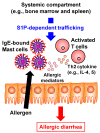Immunological function of sphingosine 1-phosphate in the intestine
- PMID: 22666543
- PMCID: PMC3347024
- DOI: 10.3390/nu4030154
Immunological function of sphingosine 1-phosphate in the intestine
Abstract
It has been shown that dietary materials are involved in immune regulation in the intestine. Lipids mediate immune regulation through a complex metabolic network that produces many kinds of lipid mediators. Sphingosine-1-phosphate (S1P) is a lipid mediator that controls cell trafficking and activation. In this review, we focus on the immunological functions of S1P in the regulation of intestinal immune responses such as immunoglobulin A production and unique T cell trafficking, and its role in the development of intestinal immune diseases such as food allergies and intestinal inflammation, and also discuss the relationship between dietary materials and S1P metabolism.
Keywords: IgA antibody; food allergy; intestinal immunity; intraepithelial T lymphocytes; lipid.
Figures




Similar articles
-
Sphingosine 1-phosphate regulates the egress of IgA plasmablasts from Peyer's patches for intestinal IgA responses.J Immunol. 2008 Apr 15;180(8):5335-43. doi: 10.4049/jimmunol.180.8.5335. J Immunol. 2008. PMID: 18390715
-
Sphingosine-1-phosphate (S1P) signaling regulates the production of intestinal IgA and its potential role in the pathogenesis of canine inflammatory bowel disease.J Vet Med Sci. 2019 Sep 3;81(9):1249-1258. doi: 10.1292/jvms.19-0016. Epub 2019 Jul 25. J Vet Med Sci. 2019. PMID: 31341112 Free PMC article.
-
The functional roles of S1P in immunity.J Biochem. 2012 Oct;152(4):305-11. doi: 10.1093/jb/mvs090. Epub 2012 Aug 24. J Biochem. 2012. PMID: 22923732 Review.
-
Sphingosine-1-phosphate in chronic intestinal inflammation and cancer.Adv Biol Regul. 2014 Jan;54:112-20. doi: 10.1016/j.jbior.2013.10.001. Epub 2013 Oct 16. Adv Biol Regul. 2014. PMID: 24210073 Free PMC article. Review.
-
The sphingosine-1-phosphate/sphingosine-1-phosphate receptor 2 axis regulates early airway T-cell infiltration in murine mast cell-dependent acute allergic responses.J Allergy Clin Immunol. 2015 Apr;135(4):1008-1018.e1. doi: 10.1016/j.jaci.2014.10.044. Epub 2014 Dec 13. J Allergy Clin Immunol. 2015. PMID: 25512083 Free PMC article.
Cited by
-
Low fish meal diet supplemented with probiotics ameliorates intestinal barrier and immunological function of Macrobrachium rosenbergii via the targeted modulation of gut microbes and derived secondary metabolites.Front Immunol. 2022 Nov 17;13:1074399. doi: 10.3389/fimmu.2022.1074399. eCollection 2022. Front Immunol. 2022. PMID: 36466900 Free PMC article.
-
Signaling through the S1P-S1PR Axis in the Gut, the Immune and the Central Nervous System in Multiple Sclerosis: Implication for Pathogenesis and Treatment.Cells. 2021 Nov 18;10(11):3217. doi: 10.3390/cells10113217. Cells. 2021. PMID: 34831439 Free PMC article. Review.
-
Washed microbiota transplantation for Crohn's disease: A metagenomic, metatranscriptomic, and metabolomic-based study.World J Gastroenterol. 2024 Mar 21;30(11):1572-1587. doi: 10.3748/wjg.v30.i11.1572. World J Gastroenterol. 2024. PMID: 38617453 Free PMC article.
-
The mucosal immune system: From dentistry to vaccine development.Proc Jpn Acad Ser B Phys Biol Sci. 2015;91(8):423-39. doi: 10.2183/pjab.91.423. Proc Jpn Acad Ser B Phys Biol Sci. 2015. PMID: 26460320 Free PMC article. Review.
-
Transcriptional modulation of SLC26A3 (DRA) by sphingosine-1-phosphate.Am J Physiol Gastrointest Liver Physiol. 2016 Jun 1;310(11):G1028-35. doi: 10.1152/ajpgi.00308.2015. Epub 2016 Apr 14. Am J Physiol Gastrointest Liver Physiol. 2016. PMID: 27079615 Free PMC article.
References
-
- Kiyono H., Kunisawa J., McGhee J.R., Mestecky J. The Mucosal Immune System. In: Paul W.E., editor. Fundamental Immunology. Vol. 6. Lippincott-Raven; Philadelphia, PA, USA: 2008. pp. 983–1030.
-
- Maslowski K.M., Mackay C.R. Diet, gut microbiota and immune responses. Nat. Immunol. 2011;12:5–9. - PubMed
-
- Margioris A.N. Fatty acids and postprandial inflammation. Curr. Opin. Clin. Nutr. Metab. Care. 2009;12:129–137. - PubMed
Publication types
MeSH terms
Substances
LinkOut - more resources
Full Text Sources
Other Literature Sources
Miscellaneous

